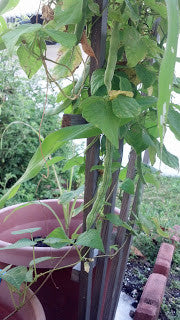
Pest Control & Prevention in the Garden
We asked our customers what issues they face in the garden and the top responses were Weeds and Bugs. Today we're going to tackle the Bugs & Pests issue. I...
Mary Smith |
Welcome to our store Learn more

We asked our customers what issues they face in the garden and the top responses were Weeds and Bugs. Today we're going to tackle the Bugs & Pests issue. I...
Mary Smith |

Before I get into any more tincture recipes I thought I'd share another one of my favorite herbs. Feverfew is actually a flowering plant. It can be grown for it's...
Mary Smith |

As promised, we are continuing to share our month-to-month, regions specific Planting Guide from Mary's Heirloom Seeds! Can you believe it's almost August? It's still super hot and we're already...
Mary Smith |

Most PEAS are a cool weather crop. Sweet Peas (garden peas), Snap Peas and Snow Peas are cool weather crops. Southern Peas are actually a legume and are heat tolerant...
Mary Smith |

At Mary's Heirloom Seeds we offer several Planting Guides to help you determine what to plant in your area. First, we have our Growing Tips and Videos page. Next, we...
Mary Smith |

We grow as much of our own organic food as we have the resources to produce and it still isn't 100%. What we do not grow we try to find...
Mary Smith |

Welcome to our 3rd installment of our Growing Organic Garlic series for 2016. First we shared How to Plant Organic Garlic and then When to Plant Garlic. Growing Garlic is...
Mary Smith |

Peppers are another excellent addition to your food garden! When to Plant Peppers Purple Jalapeno If you live in Florida, plant Peppers in January thru early March. There are...
Mary Smith |

Time to plant those Cucumbers! Preferred Growing Conditions Of course, cucumbers need lots of sun—full sun, in fact. Vegetable gardens should have 6-8 hours a full sunlight a day. Cucumbers...
Mary Smith |

Are you ready to GET PLANTING? Mary's Heirloom Seeds Newsletter JUNE Seed Planting Guide for the US by Region Seed Combo Packs "Wild about Wildflowers" seed pack combo "Mary's Salsa...
Mary Smith |

Are you ready to GET PLANTING? Mary's Heirloom Seeds Newsletter JUNE Seed Planting Guide for the US by Region Seed Combo Packs "Wild about Wildflowers" seed pack combo "Mary's Salsa...
Mary Smith |

If you search the web, you'll find that many gardeners agree on the top easy veggies to grow. We all have our challenges and our favorites. You don't have to...
Mary Smith |
Even if you have the space to grow in ground, there are many reasons to grow in containers. A few reasons to grow in containers include Save water Save space...
Mary Smith |

As promised, we now offer a complete, regions-specific vegetable seed planting guide for the US. Here's our planting guide for HAWAII. **Hawaii has many climates so this is just a...
Mary Smith |